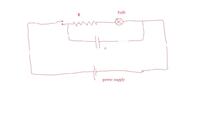loosu
Newbie level 2
i just want to make a simple circuit . the purpose of this circuit is a 12V bulb is working from 12V DC power supply .
when we switch off the power to the bulb then it needs to fade gradually and comes to a "complete off " rather than a sudden "on" (100% brightness ) to "off" (0% brightness) in a moment . i don't need time delay (i don't need 100% brightness for some period of time once we switch off the power supply , it can start to fade immediately once we switch of the power supply )
here i attached a simple diagram .
please tell me weather it is correct or not ?
if the diagram is correct what capacitor vulvae is suitable for this operation ?
if the diagram is wrong what improvement i need to do ?
the bulb here we using is 12V 10W
desired fading time 3s
please help me . .

when we switch off the power to the bulb then it needs to fade gradually and comes to a "complete off " rather than a sudden "on" (100% brightness ) to "off" (0% brightness) in a moment . i don't need time delay (i don't need 100% brightness for some period of time once we switch off the power supply , it can start to fade immediately once we switch of the power supply )
here i attached a simple diagram .
please tell me weather it is correct or not ?
if the diagram is correct what capacitor vulvae is suitable for this operation ?
if the diagram is wrong what improvement i need to do ?
the bulb here we using is 12V 10W
desired fading time 3s
please help me . .

